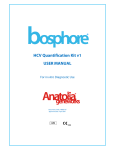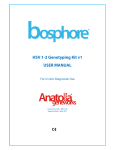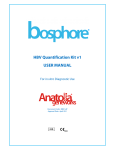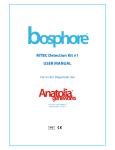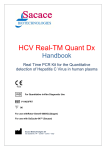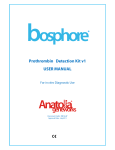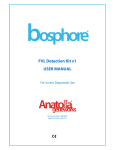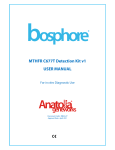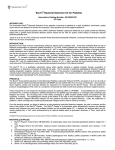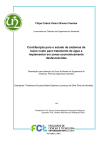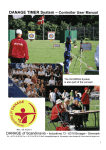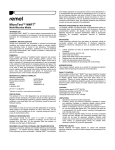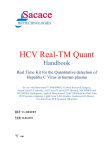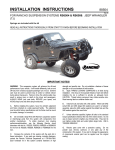Download CMV Quantification Kit v1 USER MANUAL
Transcript
® CMV Quantification Kit v1 USER MANUAL For in vitro Diagnostic Use ® Code: MB04v1f Date: July 2011 1434 Contents Page 1. Product Description 1 2. Content 1 3. Storage 1 4. Required Materials and Devices 1 5. Important Notes and Safety Instructions 2 6. Product Use Limitations 2 7. Pathogen 2 8. Method 3 9. Procedure 3 9.1. Sample Preparation, Storage and Transport 3 9.2. Interfering Substances 4 9.3. DNA Isolation 4 9.4. Kit Components 4 9.4.1. PCR Mix 4 9.4.2. Detection Mix 1 4 9.4.3. Detection Mix 2 4 9.4.4. Internal Control 4 9.4.5. Positive Control 5 9.4.6. Quantitation Standards 5 9.5. Preparing the PCR 5 9.6. Programming the Montania® 483 Real-Time PCR Instrument 5 10. Analysis 7 11. Troubleshooting 10 Code: MB04v1f Date: July 2011 ii 12. Specifications 9 12.1. Sensitivity 10 12.2. Linear Range 10 12.3. Cross-Reactivity 11 12.4. Reproducibility and Precision 11 12.5. Diagnostic Evaluation 12 13. References 12 14. Symbols 13 15. Contact Information 13 Code: MB04v1f Date: July 2011 iii 1. PRODUCT DESCRIPTION Bosphore® CMV Quantification Kit v1 detects and quantitates Cytomegalovirus DNA in human serum, encompassing all major CMV genotypes. The linear range of quantitation is 1.6x107-1.6x102 copies/ml and the analytic sensitivity is 1.2x102 copies/ml. A region within the DNA Polymerase gene is amplified and the detection is accomplished using the FAM filter. To check PCR inhibition an internal control is incorporated into the system. The internal control is detected with the Cy5 filter. The internal control can be added into the PCR reaction mix. Quantitation of the viral load is done using internationally accepted DNA quantitation controls. 2. CONTENT Bosphore® CMV DNA Quantification Kit v1 is composed of PCR reagents and DNA standards: Component 1 2 3 4 5 6 7 8 9 10 Reagent dH2O PCR Mix Detection Mix1 Detection Mix2 İnternal Kontrol Pozitif Kontrol 1 Standard 1 (1 x 106 copies/ml) Standard 2 (1 x 105 copies/ml) Standard 3 (1 x 104 copies/ml) Standard 4 (1 x 103 copies/ml) 100 Tests (1000 µl) (2240 µl) (228 µl) (132 µl) (15 µl) (70 µl) (140 µl) (140 µl) (140 µl) (140 µl) 50 Tests (1000 µl) (1120 µl) (114 µl) (66 µl) (15 µl) (35 µl) (70 µl) (70 µl) (70 µl) (70 µl) 25 Tests (500 µl) (560 µl) (57 µl) (33 µl) (15 µl) (17,5 µl) (35 µl) (35 µl) (35 µl) (35 µl) 3. STORAGE Bosphore® CMV Quantification Kit v1 PCR reagents should be stored at -20°C, the serum standards can be stored at -80°C. Repeated thawing and freezing (>3x) should be avoided since it may reduce sensitivity. If the components are to be used in small amounts, they should be frozen in aliquots. While preparing the PCR the components should not be exposed to room temperature for more than 10-15 min. The detection mix components should not be exposed to light more than 1-2 min. The components maintain their stability until the expiry dates on the labels, if they are stored at proper conditions. 4. REQUIRED MATERIALS AND DEVICES • Montania® 483 Real-Time PCR Instrument (Anatolia Geneworks), or another Real-Time PCR system with FAM and Cy5 filters (iCycler, iQ5, CFX–BioRad, LightCycler 1.5, 2.0, 480-Roche, 7500 Real-Time PCR System-ABI, Stratagene Mx3005P, Mx3000P-Agilent, LineGeneK, LineGene 9600-Bioer, Rotorgene 2000, 3000, 6000, Q-Qiagen) • 0.2 ml Thin-Wall PCR strips or tubes. • Magnesia® 16 Nucleic Acid Extraction System / Magnesia® Viral Nucleic Acid Extraction Kit. (Anatolia Geneworks) • Deep freezer (-20°C) • Vortex mixer • Desktop centrifuge with rotor for 2 ml. microcentrifuge tubes • Adjustable micropipettes • Sterile micropipette tips with filters Code: MB04v1f Date: July 2011 1 • Sterile 1.5 or 2 ml. microcentrifuge tubes • Disposable gloves 5. IMPORTANT NOTES AND SAFETY INSTRUCTIONS Caution!: • The product should be delivered on dry ice. Check for presence of dry ice upon arrival, and do not use products that have been delivered without it. • Check for the expiry dates on the box and tube labels, upon arrival. Do not use expired products or components. Attention should be paid also to the following points: • Sterile micropipette tips with filters, and sterile microcentrifuge tubes should be used • Before starting a test procedure all components should be thoroughly thawed at room temperature. After thawing, all components should be mixed and centrifuged briefly, to ensure homogeneity prior to use. • The kit components should be kept on ice or a cooling block until the reaction is prepared, and they should be quickly returned to -20ºC. • PCR and nucleic acid isolation should be performed in different compartments. Samples should be stored separately to avoid contact with the kit components. The safety instructions below should be followed: • Serum samples (including the standards) should be handled with extreme caution: Physical contact with pathogens should be avoided by; wearing lab coats and gloves, no allowance for eating or drinking within the workspace, prevention of unauthorized individuals’ access to the working area. • Pathogenic wastes (serum samples and material contaminated with them) produced during the nucleic acid isolation step, should be discarded into medical waste and disposed safely. • Pathogen information should be reviewed for the health risks. 6. PRODUCT USE LIMITATIONS • All the components may exclusively be used for in vitro diagnostics. • This product should be used in accordance with this user manual. • This product is to be used by personnel specially trained to perform in vitro diagnostic procedures. 7. PATHOGEN Causative Agents Cytomegalovirus belongs to the herpes family and is composed of a linear, double stranded DNA genome containing aproximatally 230,000 base pairs. It is believed that cytomegalovirus genome contains nearly 165 protein-encoding genes. This virus is also known as Human Herpes Virus 5 (HHV5). HCMV is among the TORCH infections (Toxoplasmosis, Others, Rubella, Cytomegalovirus, Herpes) that are known to cause congenital anomalies. [1], [2] Code: MB04v1f Date: July 2011 2 Epidemiology Infection is common with seroprevalence rates increasing steadily from 65 % among 40 to 49 year olds to 91% in those aged 80 years or older. [1],[3] Congenital CMV infection, being the most common congenital viral infection, is a significant health problem in developed countries. It is responsible for the neurodevelopmental pathological changes, involving hearing loss. CMV infection is seen in 1% of newborn infants and CMV causes serious life threatening problems in 10% of these infants. The morbidity rates of CMV are 90-95 % whilst the mortality rates are 4-37%. [3],[4] Modes of Transmission CMV infection can be transmitted via body fluids such as urine, saliva, tear, blood, sexual contact, plesantal contact, breast milk and via solid organ transplantations or blood transfusions. Transmission of this virus could easily be prevented because the ubiquitous way of transmission is contact with the body fluids and if hands are washed with soap after the contact, the risk of transmission can be prevented. The most common way of HCMV transmission is from mother to child in uterus or via perinatal phase (during birth). [5],[6] 8. METHOD Bosphore® CMV Quantification Kit v1 is based on the real-time PCR principle. The pathogen is detected using fluorescent dyes that are incorporated into oligonucleotide probes. The assay utilizes the 5’ exonuclease activity of Taq Polymerase to cleave a dual-labeled fluorescent hybridization probe during the extension phase of PCR. The probe is labeled at the 5’ end with a fluorescent ‘reporter’ molecule, and at the 3’end with another fluorescent molecule that acts as a ‘quencher’ for the ‘reporter’. When the two fluorophores are in close proximity and the reporter is excited by light, no reporter fluorescence can be detected. During the elongation step of PCR, Taq Polymerase encounters and cleaves the probe bound to the template. As the reporter is released from the suppressing effect of the quencher, fluorescence signal can be detected. At each cycle of the reaction the product that is formed is sensitively detected by the increase in the fluorescence level. The fluorescence generated by the reporter increases as the PCR product is accumulated; the point at which the signal rises above background level and becomes distinguishable, is called the threshold cycle (CT). There is a linear relationship between the log of the starting amount of a template and its threshold cycle, thus starting amount of unknown templates can be determined using standard curves constructed using CT values of the known starting amounts of target templates. In contrast to conventional PCR, Real-Time PCR eliminates the need for further analysis methods like gel electrophoresis, whereby minimizing the risk of contamination. 9. PROCEDURE 9.1. Sample Preparation, Storage and Transport To isolate serum from the clinical specimen, the blood sample should be collected into sterile vacutainers without any anticoagulant. For venipuncture, only sterile material should be used. Attention: EDTA or heparin containing vacutainers should not be used for sample collection. Code: MB04v1f Date: July 2011 3 The serum should be separated from blood within 6 hours after blood collection. To separate the serum, the blood container should be centrifuged at 800-1600 x g for 20 minutes. The separated serum should be transferred to polypropylene tubes and stored at -20ºC or lower, until use. The samples should be transported in containers with capacity to resist pressure. Transportation should be done according to local and national regulations for pathogen material transport. 9.2. Interfering Substances To avoid possible influences on PCR: • Hemolytic samples, • Samples of heparinised patients, • Samples of patients with elevated levels of bile salts, bilirubin or lipids must not be used. 9.3. DNA Isolation We recommend that the Magnesia® 16 Nucleic Acid Extraction System / Magnesia® Viral Nucleic Acid Extraction Kit. (Anatolia Geneworks) isolation system or an alternative high quality DNA extraction system is used with Bosphore® CMV Quantification Kit v1. The DNA isolation should be performed according to the manufacturers’ instructions. The starting volume is 400 µl, the elution volume is 60. 9.3.1. PCR Mix HotStarTaq DNA Polymerase: HotStarTaq DNA Polymerase is a modified form of a recombinant 94 kDa DNA polymerase, originally isolated from Thermus aquaticus, cloned into E.Coli. The enzyme is provided in an inactive form. It is activated by a 15-minute 95 ºC incubation step. This prevents the formation of misprimed products and primer-dimers during reaction setup and the first denaturation step, leading to high PCR specificity and accurate quantification. QuantiTect Probe PCR Buffer: contains Tris-Cl, KCl, (NH4)2SO4, 8 mM MgCl2, pH 8.7 (20ºC ). dNTP Mix: Contains ultrapure quality dATP, dGTP, dCTP ve dTTP/dUTP. 9.4.2. Detection Mix 1 Detection Mix 1 contains CMV-specific forward and reverse primers and a dual-labeled probe. 9.4.3. Detection Mix 2 Detection Mix 2 contains internal control-specific forward and reverse primers and a dual-labeled probe. 9.4.4. Internal Control An internal control is included in the kit to control PCR inhibition. The internal control is a synthetic DNA molecule derived from human genome. It is added directly into the PCR master mix to control the PCR inhibition exclusively. For this purpose, 0.1 µl of internal control should be added for each reaction into the master mix. The internal control generally has a Ct of 34 ± 3. Lack of internal control amplification in the FAM negative samples, may indicate a problem in PCR or PCR inhibition. In this case, PCR should be repeated. In samples that contain a high bacterial load, internal control can be suppressed and no increase of the signal is detected. Please use the table below for the interpretation of internal control data: Code: MB04v1f Date: July 2011 4 CMV (FAM) + + - 9.4.5. Internal Control (Cy5) + + - Interpretation Sample positive Sample negative Sample positive Repeat the test! Positive Control The positive control contains CMV DNA. It can be included in the PCR to test the efficiency of the PCR exclusively. The threshold cycle for the positive control is given in the acceptance criteria table (Section 10. Analysis). Threshold cycles higher than the acceptance criteria may indicate an efficiency loss in the reaction. 9.4.6. Quantitation Standards Quantitation of the viral load is performed using four quantitated DNA controls, ranging from 1 x 103 copies/ml to 1 x 106 copies/ml. 9.5. Preparing the PCR All four external quantitation standards should be added into the PCR reaction together with the samples and the negative control (PCR-grade water). Make sure that all the kit components are thawed before use. Refer to the table below for preparing the PCR. It is for only one reaction, multiply these values with the sample number to find the values required for the master mix. While preparing master mixes for more than 5 samples, an extra 10% should be added to the total sample number. PCR Mix Detection Mix 1 Detection Mix 2 Internal Control dH2O Sample DNA Standard Negative/Positive Control 20 µl 2.1 µl 1.2 µl 0.1 µl 0.6 µl Total Volume 40 µl 16 µl Pipette 24 µl of the master mix into the PCR tubes or strips, and add 16 µl of DNA (sample/ standard/positive or negative control). Close the tube cap. Make sure that the solution in each tube is at the bottom of the tube. Centrifuge if necessary. 9.6. Programming the Montania® 483 Real-Time PCR Instrument The thermal protocol for Bosphore® CMV Quantification Kit v1 is composed of an initial denaturation for activation the HotStarTaq DNA Polymerase, a two-step amplification cycle and a terminal hold. The real-time data is collected at the second step of the amplification cycle. Initial denaturation Denaturation Annealing and Synthesis Code: MB04v1f Date: July 2011 95°C 97°C 53°C 14:30 min. 00:30 min. 01:30 min. 50 cycles 5 (Data Collection) Hold 22°C 10 Before starting a Real-Time PCR reaction using the Bosphore® Kits, the following steps should be completed: • Choose the filter pairs to be used (FAM and Cy5), • Identify unknown samples, standards, positive and negative controls, assign quantitative values to the standards, • Select the correct thermal protocol. These steps are described below: From the main menu of the MONTANIA® 483 Real-Time PCR Instrument File and then New is selected. “Create a new Experiment” is selected. In the “Select Channel” window channels 1 (FAM) and 3 (Cy5) are selected (Fig. 1). Standards, samples and negative controls are identified in the “Module Edit” menu (Fig. 2). For the standards the concentration should also be entered. To select the thermal protocol “Gene Amplification” menu is used. The “Open” button in the “Experiment Program” is clicked and the appropriate thermal protocol is selected. (Fig. 3a).The thermal cycles of the selected protocol is displayed. The experiment starts by clicking the “Start” button (Fig. 3b). Fig. 1: Selecting the Filters in Montania® 483 Code: MB04v1f Date: July 2011 6 Fig. 2: Sample Location and Identification Fig. 3: a) Selecting the Thermal Protocol Fig. 3: b) Starting the Experiment 10. ANALYSIS By the end of the thermal protocol, the Montania® 483 Real-Time PCR Instrument software automatically calculates the baseline cycles and the threshold. Example of an amplification curve is given in Fig. 4. Code: MB04v1f Date: July 2011 7 Fig. 4: Amplification Curve of a Bosphore® CMV v1 test The standard curve is plotted using the data obtained from the defined standards, with the axes Ct-Threshold Cycle and Log Starting Quantity. Example of a standard curve is given in Fig. 5. Fig.5: Standard Curve of a Bosphore® CMV v1 test Analysis of the results should be performed by trained personnel who have received the required training for analysing Real-Time PCR data. We recommend that the test’s results must be evaluated by an expert clinician, taking the patient’s clinical findings and the results of other tests into consideration. All analysis is done automatically in routine use. However, when the trained personnel, who have received the required training from manufacturer, consider it as necessary, the system allows pulling down the threshold as much as possible in order to detect low positive samples. In this case, attention should be paid to keep the threshold line above the background and to keep the correlation coefficient at the maximum possible value (and within its acceptance criteria.) The table below displays the acceptance criteria for Bosphore® CMV v1. Code: MB04v1f Date: July 2011 Component/Parameter Cycle Threshold (CT) Standard 1 26±2 Standard 2 29±2 Standard 3 32.5±2 Standard 4 35.5±2 Positive Control 33±4 Correlation Coefficient >0.950 PCR Efficiency >%60 8 Test results should not be reported unless the assay results meet the criteria stated above. Please contact the manufacturer if an impairment in the product’s performance is observed (See the last page for contact information). The quantitative results of the test are displayed on the “Report Mode” screen. A spread sheet containing the calculated starting quantities of the unknown samples in each tube is shown. The samples that cross the threshold in Channel 1 (FAM) are displayed with a calculated starting quantity, samples that do not cut the threshold are displayed as “No Ct”. These samples are regarded as having a viral load below the detection limit of the assay. For these undetectable samples the Cy5 data of the internal control should also be checked to avoid false negative results Fig. 6). Fig. 6: The Report Mode Screen Showing the Results The following table shows the possible results and their interpretation: Signal detected in FAM filter pair The sample contains CMV DNA, the result is positive No signal in FAM, signal in Cy5 The CMV DNA in the sample is not detectable The diagnosis is inconclusive No signal in FAM and Cy5 No need to check the internal control since the sample is positive (high positive samples may suppress the signal from the internal control) Signal from Cy5 filter pair rules out the possibility of PCR inhibition No signal in Cy5 points out to PCR inhibition (See 11.Troubleshooting) 11. TROUBLESHOOTING Please contact the manufacturer in case of a problem during a run. Late or no signal from the FAM filter Wrong thermal Make sure that the correct thermal protocol is protocol is chosen chosen. Late or weak signal from the standards Deterioration of Don’t use expired standards or kit components. the standards or Follow the instructions for the storage of kit the core kit components (Section 2. Storage). components No signal from the internal control Deterioration of the internal control or detection mix 2 PCR inhibition Code: MB04v1f Date: July 2011 Follow the instructions for the storage of kit components (See 2. Storage). Make sure that you use the recommended DNA isolation method (See 9.3 DNA isolation). 9 DNA lost during isolation Make sure that you use the recommended DNA isolation method (See 9.3 DNA isolation). Signal from FAM Filter in the Negative Control Contamination Use filter-tips. Repeat PCR with new kit components. The Threshold is Above Low Signals The threshold Using the mouse pull the threshold down until it should be cuts the low signals. Avoid the background and manually adjusted the signal from negative control. Uneven Traces Baseline cycles should be readjusted Assing new baseline cycles manually and recalculate threshold cycles. 12. SPECIFICATIONS 12.1. Sensitivity Analytical sensitivity may be expressed as the limit of detection: i.e. the smallest amount of the target marker that can be precisely detected. The detection limit of an individual analytical procedure is the lowest amount of nucleic acid in a sample which can be detected but not necessarily quantitated as an exact value. The analytical sensitivity or detection limit for NAT assays is expressed by the 95% positive cut-off value. The analytical detection limit for Bosphore® CMV v1 was found to be 1.2x102 Copies/ml (p=0.05). The sensitivity was determined using serial DNA dilutions. The results were analyzed by probit method. 12.2. Linear Range The linear range of Bosphore® CMV Quantification Kit v1 was determined to be 1.6x107-1.6x101 copies/ml. In order to assess the linear range, a dilution series of a quantitated DNA Control was analyzed by testing each dilution in 3 replicates (Fig. 7a). The standard curve coefficient was found to be 0.99938 (Fig. 7b). Fig.7a Linear Range Amplification Curve Code: MB04v1f Date: July 2011 10 Fig.7b: Linear Range Standard Curve 12.3. Cross-Reactivity To eliminate potential cross-reactivity, assay design evidence was used. Primer and probe sequences were checked for possible homology to other known pathogen sequences by sequence comparison analysis using database alignment. HBV, EBV, MTBC, Parvovirus B19, HSV and BKV samples with known high positivity were tested and found negative in cross-reactivity experiments. 12.4. Reproducibility and Precision Precision and reproducibility data (on CT value basis and on quantitation basis) were obtained by the analysis of the 1.6x1x104 copies/ml) quantitation control. Test was performed in at least 4 replicates by 3 different operators, on multiple days, using 3 different lots. The resulting data is given in Table 1 and 2: Table 1: Reproducibility Data. CMV (1.6x104 copies/ml) Code: MB04v1f Date: July 2011 Standard Variance deviation Coefficient of variation [%] Intra-assay Variability N=8 0,08 0,006 0,24 Inter-lot Variability N=3 0,14 0,01 0,42 Inter-operator Variability N=3 0,18 0,03 0,56 Total Inter-assay Variability N=6 0,16 0,02 0,50 11 Table 2: Precision Data. CMV Measured Standard Coefficient Threshold Standard (1.6x104 Quantity Deviation of Cycle Deviation copies/ml) (MQ) (MQ) variation (Ct) (Ct) IU / ml [%] (MQ) Intraassay Variability N=8 18015 799,27 4,43 33,09 0,05 Inter-lot Variability 17723,75 N=3 539,17 3,04 33,09 0 Interoperator 16014,17 Variability N=3 2829,60 17,66 33,17 0,12 Total Inter16456,94 assay Variability N=6 2142,77 13,02 33,14 0,09 12.5. Diagnostic Evaluation The diagnostic evaluation was performed by testing 25 CMV negative serum samples which have been previously analyzed using Fluorion CMV QNP 3.0 Real-Time PCR system (Iontek). All of the negative samples were also negative, and all of the positive samples were also positive with Bosphore® CMV Quantification Kit v1. 9 CMV positive serum samples and 1 negative serum sample which have been previously analyzed using COBAS CMV DNA Amplicor were tested with Bosphore® CMV Quantification Kit v1. All the positive samples were found to be positive, and the negative sample was found negative. 13. REFERENCES 1. Mach M, Stamminger T, Jahn G, Human Cytomegalovirus: Recent Aspects from Molecular Biology, J. gen. Virol.,1989;70:3117-3146. 2. Stegmann BJ, Carey JC, TORCH Infections. Toxoplasmosis, Other (syphilis, varicella-zoster, parvovirus B19), Rubella, Cytomegalovirus (CMV), and Herpes infections, Curr Womens Health Rep. 2002;2(4):253-8. 3. Staras SAS, Dollard SC, Radford KW, Flanders WD, Pass RF, Cannon MJ: Seroprevalence of cytomegalovirus infection in the United States, 1988–1994. Clin Infect Dis 2006, 43(9):1143-1151. 4. Hodinka RL, Friedman HM, Human Cytomegalovirus, in: Balows A (ed), Manuel of Clinical Microbiology, 5'th ed, Washington: American Society for Microbiology, 1991, pp: 829-36. 5. Adler SP, Transfusion-associated cytomegalovirus infections. Review oflnfeetious Diseases 5, 1983:977-993 6. Mandell GL, Bennett JE, Dolin R., Principles and practice of infectious diseases, 5th ed. Philadelphia: Churchill Livingstone, 2000: 1586-96. Code: MB04v1f Date: July 2011 12 14. SYMBOLS Use by Lot/Batch REF Catalog number Temperature limitation Caution, consult accompanying documents Manufacturer IVD In Vitro Diagnostic Medical Device 15. CONTACT INFORMATION ® AnatoliaTanı ve Biyoteknoloji A.Ş. Egitim Mh. Kasap Ismail Sk. No:10/23 Kadikoy 34722 ISTANBUL-TURKEY Phone: +90 216 330 04 55 Fax: +90 216 330 00 42 E-mail: [email protected] www.anatoliageneworks.com Registered Trademarks: Anatolia Geneworks® Montania®, Magnesia® and Bosphore® are registered trademarks of Anatolia Tani ve Biyoteknoloji Inc. Code: MB04v1f Date: July 2011 13
















